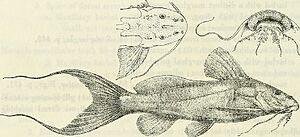Synodontis caudalis facts for kids
Quick facts for kids Synodontis caudalis |
|
|---|---|
 |
|
| Conservation status | |
| Scientific classification | |
| Genus: |
Synodontis
|
| Species: |
caudalis
|
The filament tailed synodontis or whiptail synodontis (scientific name: Synodontis caudalis) is a special kind of upside-down catfish. It lives in the Democratic Republic of the Congo in Africa. A scientist named George Albert Boulenger first described this fish in 1899. Its name, caudalis, comes from a Latin word meaning "tail." This is because it has long, thin parts on its tail fin.
What Does It Look Like?
Like other Synodontis fish, the filament tailed synodontis has a strong, bony head. This head bone goes all the way back to its first fin on its back. It also has a unique bony bump on its shoulder area. This bump is called a humeral process. Its shape helps scientists tell different Synodontis species apart. For S. caudalis, this bump is narrow and pointy.
This fish has three pairs of barbels, which are like whiskers. One pair is on its upper jaw. Two pairs are on its lower jaw. The upper jaw barbels are straight and do not have branches. They are about one and a half to one and two-thirds the length of its head. The outer barbels on the lower jaw are longer than the inner ones. They are about two-thirds the length of its head.
The front edges of the fins on its back and sides are stiff spines. In S. caudalis, the spine on its back fin is short. It is about two-thirds the length of its head. This spine is smooth in the front but rough on the back. The rest of this fin has seven soft rays. The spine on its side fin is about as long as the back fin spine. It is rough on both sides.
The small, fleshy fin near its tail is called the adipose fin. It is about four to five times longer than it is deep. The fin on its belly has three unbranched rays and eight or nine branched rays. Its tail fin is forked, like a "V" shape. Both parts of the tail end in a long, thin filament.
All Synodontis fish have a special pad of teeth on their upper jaw. This is called a premaxillary toothpad. It has several rows of short, chisel-shaped teeth. In S. caudalis, this toothpad is long and fairly wide. On its lower jaw, the teeth are attached to flexible, stalk-like parts. These teeth are often described as "s-shaped" or "hooked." The number of teeth on the lower jaw helps identify the species. S. caudalis has about 70 to 80 teeth on its lower jaw.
The body of this fish is a plain brownish color. It can grow up to about 20.4 centimeters (8 inches) long. Female Synodontis fish are usually a bit bigger than males of the same age.
Where Does It Live and What Does It Do?
In the wild, the filament tailed synodontis lives in the fast-moving waters of the lower Congo River system. It is also found in a lake-like area called Pool Malebo. You can also find it in the Fimi River and parts of the Kasai River system.
Scientists do not know much about how most Synodontis species have babies. They have found eggs in some female fish. It is thought that they lay eggs during the flooding season. This usually happens between July and October. Pairs of fish likely swim together when they are laying eggs.
Synodontis fish are generally omnivores. This means they eat both plants and animals. Their diet includes insect larvae, algae, snails, clams, sponges, and small crustaceans. They also eat the eggs of other fish. These fish grow quickly in their first year. After that, their growth slows down as they get older.


